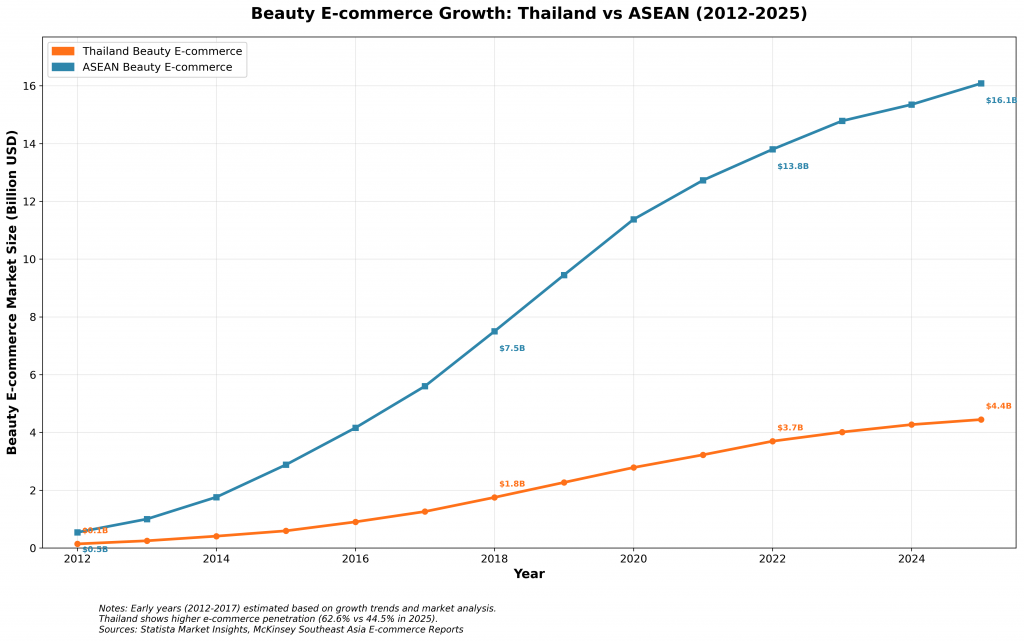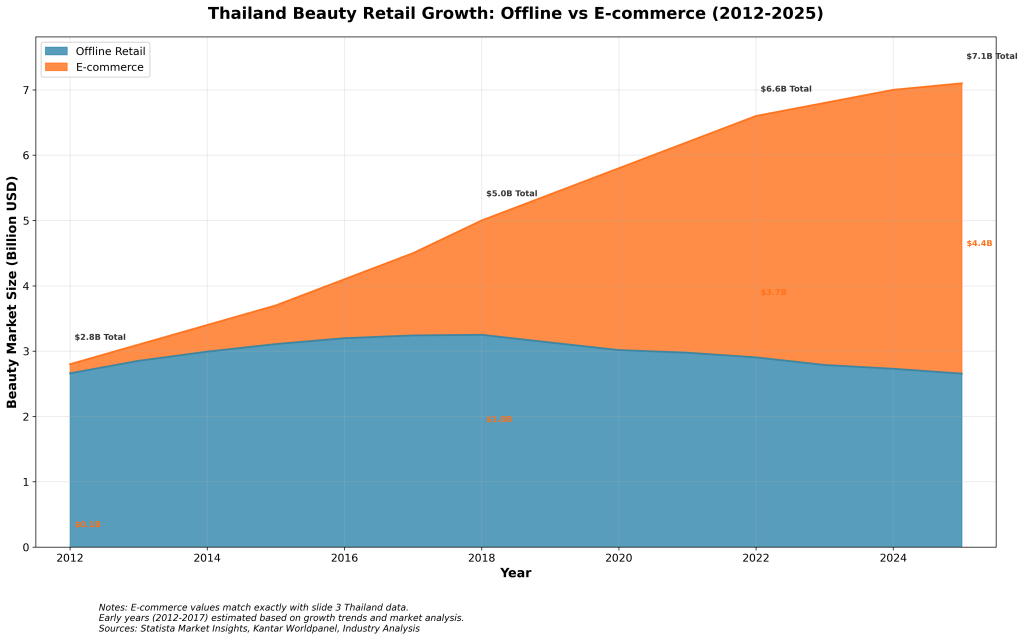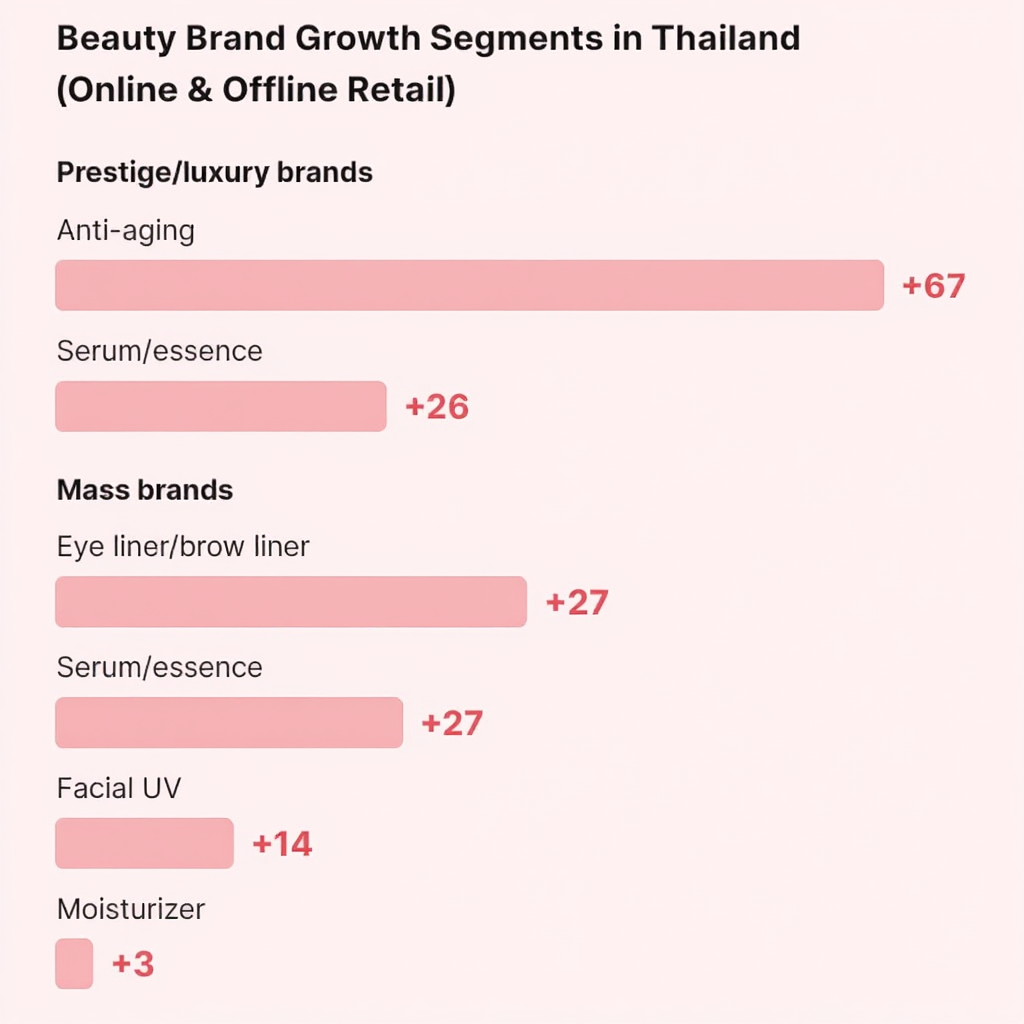In 2012, Thailand’s beauty market was worth $2.8 billion, and e-commerce was essentially non-existent. By 2025, that same market will hit $7.1 billion, with 59% of it happening online. But here’s the kicker: Thailand now commands 27% of ASEAN’s entire $16.1 billion beauty e-commerce market.
As Konvy, Thailand’s leading beauty e-commerce platform, celebrates its 13th anniversary this month, their journey from a 100,000 baht startup to the country’s No.1 beauty retailer perfectly encapsulates this transformation. But more importantly, it shows how first-mover advantage, when executed correctly, can create sustainable market leadership even as giants enter the space.

The Great Digital Migration
Let me start with what actually happened here, because the transformation is more dramatic than most people realize. Thailand didn’t just add e-commerce to its existing beauty market — it fundamentally rewired how an entire industry operates.

In 2012, if you wanted to buy beauty products in Thailand, you went to a store. Period. The infrastructure for online beauty retail barely existed, consumer trust in digital payments was low, and the logistics networks couldn’t handle the complexity of beauty product fulfillment. Fast forward to 2025, and nearly 6 out of every 10 beauty purchases happen online.
This isn’t just about convenience or COVID acceleration — though both played a role. This is about Thailand building digital-first beauty infrastructure that leapfrogged traditional retail entirely. While Western markets were trying to digitize existing retail chains, Thailand was building something new from the ground up.
The data from Statista Market Insights and McKinsey’s Southeast Asia e-commerce reports shows Thailand’s beauty e-commerce growing from $0.5 billion in 2012 to $4.4 billion in 2025. That’s not linear growth — that’s exponential adoption happening at scale across a market of 70 million people.
The Konvy Blueprint: How to Build Market Leadership from Scratch
Here’s where Konvy’s story becomes instructive for every founder thinking about emerging market opportunities. In 2011, QingGui Huang, a Chinese entrepreneur who had spent part of his childhood in Thailand, returned to Bangkok with his life savings and a hypothesis: Thai consumers loved beauty products, but there was no dedicated online platform serving them.
He started with 100,000 baht (about $3,000) and a single room in a friend’s condominium. No venture capital, no grand strategy deck, just direct observation of consumer behavior and a willingness to solve a real problem.
What Konvy got right from day one was understanding that beauty e-commerce isn’t just about putting products online — it’s about solving the trust and discovery problems that keep consumers from buying beauty products sight unseen. They focused on authentic products, detailed descriptions, and building a reputation for reliability when the entire concept of online beauty shopping was foreign to Thai consumers.
But here’s the crucial part: they evolved with the market. As Huang puts it, the initial challenge was consumer access — helping people find imported brands and new products they couldn’t afford to buy offline. But over the next decade, the challenge became the “content problem” — providing enough information and being present in the right channels for consumers to make informed decisions.
Today, Konvy operates across multiple channels: their own e-commerce platform, major marketplaces, and offline retail stores. They’ve grown from a single website to Thailand’s No.1 beauty e-commerce platform, carrying over 1,000 global and local brands and 20,000 products. In 2024, they raised $11 million from strategic investors including Alibaba International and New Day Ventures to expand regionally.
Platform Wars and the TikTok Shop Revolution
But here’s where the story gets really interesting for founders and investors: the platform dynamics that drove this transformation are unlike anything we’ve seen in Western markets.

Traditional e-commerce platforms like Lazada are growing at a respectable 8% year-over-year. Shopee, the regional heavyweight, is posting solid 68% growth. But TikTok Shop? They’re growing at 341% in beauty e-commerce.
That’s not a typo. Three hundred and forty-one percent.
What we’re witnessing is the emergence of social commerce as the dominant force in beauty retail, and it’s happening faster in Thailand than anywhere else in the world. TikTok Shop isn’t just another sales channel — it’s fundamentally changing how beauty brands think about customer acquisition, product discovery, and conversion.
Think about the implications. In Western markets, beauty brands still spend massive budgets on traditional advertising, then hope customers find their way to their e-commerce sites. In Thailand, the discovery, education, and purchase all happen in the same app, in the same session, often in the same video.
This isn’t just about lower customer acquisition costs — though those are significant. It’s about building businesses that are native to how consumers actually behave online. When your entire sales funnel exists within a single social platform, you’re not fighting against consumer behavior — you’re building with it.
For established players like Konvy, this represents both opportunity and challenge. They’ve had to evolve from being a destination site to being present wherever their customers are — including TikTok Shop, traditional marketplaces, and their own platforms. The companies that survive this transition are those that view platforms as distribution channels rather than competitors.
The Premium Beauty Paradox

Here’s something that surprised me when I dug into the segment data: premium and luxury beauty brands are driving the highest growth rates in Thailand’s digital transformation, posting 67% growth compared to 9% for mass-market makeup brands.
This challenges a lot of conventional wisdom about emerging markets. The standard playbook says you start with affordable products, build trust, then gradually move upmarket. Thailand’s beauty consumers skipped that entire progression.
Why? Because digital platforms solved the trust and authenticity problems that traditionally kept consumers away from premium beauty products. When you can see detailed product reviews, watch tutorial videos, and get authentic user-generated content all in one place, the risk of buying a $50 serum online drops dramatically.
But there’s something deeper happening here. Thailand’s beauty consumers aren’t just buying premium products — they’re using digital platforms to educate themselves about skincare science, ingredient benefits, and application techniques. The platforms aren’t just facilitating transactions; they’re creating more sophisticated consumers who are willing to pay for quality.
This has massive implications for beauty brands thinking about emerging market expansion. The old model of launching with entry-level products and slowly building brand equity is being disrupted by platforms that can compress that entire journey into months instead of years.
Konvy’s success with premium brands illustrates this perfectly. They’ve built their reputation by ensuring product authenticity and providing detailed product information — exactly what premium beauty consumers need to feel confident about online purchases. Their “100% authentic” guarantee isn’t just marketing; it’s the foundation of their business model.
The Infrastructure That Made It Possible
None of this happens in a vacuum. Thailand’s beauty e-commerce explosion was enabled by infrastructure investments that most people never see but that every founder should understand.
First, logistics. Thailand built one of the most sophisticated last-mile delivery networks in Southeast Asia, with same-day delivery available in Bangkok and next-day delivery reaching 80% of the population. When you’re selling products that consumers want to touch and feel before buying, delivery speed becomes a competitive advantage.
Second, payments. Thailand’s digital payment infrastructure evolved rapidly, with mobile wallets achieving 60% adoption rates and seamless integration with social commerce platforms. When the friction between “I want this” and “I own this” drops to a single tap, conversion rates explode.
Third, content creation tools. Thailand developed a robust ecosystem of beauty influencers, tutorial creators, and user-generated content that made social commerce feel authentic rather than promotional. The platforms provided the tools, but Thai creators built the trust.
But here’s what’s really interesting: this infrastructure wasn’t built by the government or traditional retailers. It was built by the platforms themselves, working directly with logistics providers, payment companies, and content creators. The entire ecosystem evolved organically around consumer demand.
Companies like Konvy played a crucial role in this infrastructure development. As one of the earliest players, they had to solve logistics, payments, and trust issues before the broader ecosystem matured. Their early investments in these capabilities became competitive advantages as the market scaled.
Lessons from 13 Years of Market Building
As Konvy celebrates its 13th anniversary, their journey offers specific lessons for founders building in emerging markets:
Start with real consumer pain, not market size. Huang didn’t choose beauty because it was the biggest market — he chose it because Thai consumers clearly wanted something that didn’t exist. The market size followed the solution, not the other way around.
Build for the market you’re in, not the market you wish you had. Konvy succeeded because they understood Thai consumer behavior and built for it, rather than trying to copy Western e-commerce models. They evolved their approach as the market matured.
First-mover advantage is real, but only if you keep moving. Being first gave Konvy a head start, but staying ahead required constant evolution. They’ve had to reinvent their business model multiple times as platforms, consumer behavior, and competitive dynamics changed.
Platform diversification is survival. Konvy’s expansion across multiple channels — their own site, marketplaces, social commerce, and offline retail — shows how successful companies adapt to changing platform dynamics rather than fighting them.
What This Means for Founders Everywhere
If you’re building in beauty, e-commerce, or emerging markets, Thailand’s transformation offers four lessons that could reshape how you think about market entry and growth strategy.
Build for mobile-first, social-native commerce. Thailand’s beauty brands didn’t just put their products on social platforms — they rebuilt their entire customer experience around social discovery and purchase. If your go-to-market strategy still assumes customers will visit your website, you’re already behind.
Premium positioning works in emerging markets if you solve the trust problem. Thailand’s premium beauty growth proves that consumers in emerging markets will pay for quality when platforms provide sufficient social proof, education, and authenticity signals. Don’t default to the cheapest possible product — default to the highest value you can deliver.
Platform dynamics matter more than market size. Thailand’s beauty market is smaller than Indonesia’s or Vietnam’s, but it’s more valuable to beauty brands because the platform ecosystem is more mature. When evaluating markets, look at platform penetration and social commerce adoption, not just GDP per capita.
Infrastructure follows demand, not the other way around. Thailand didn’t wait for perfect logistics or payment systems before building beauty e-commerce. The platforms created demand, then the infrastructure evolved to meet it. If you’re waiting for perfect market conditions, you’re waiting too long.
The Bigger Picture
Thailand’s beauty e-commerce story is really a story about how emerging markets can leapfrog developed ones when the right conditions align. While Western beauty brands were still figuring out how to integrate social media with e-commerce, Thailand was building businesses that were social-native from day one.
The result? A market that’s more digitally sophisticated, more platform-native, and more willing to embrace new commerce models than many developed markets. Thailand’s beauty consumers aren’t catching up to Western shopping behaviors — they’re defining what the future of beauty retail looks like.
For investors, this represents a fundamental shift in how we should think about emerging market opportunities. The old model assumed emerging markets would follow the same development path as developed ones, just with a time lag. Thailand’s beauty transformation shows that emerging markets can skip entire evolutionary steps and build something better from scratch.
For founders, the lesson is even more direct: the biggest opportunities aren’t in copying what works in developed markets. They’re in building for how consumers actually behave in emerging markets, then scaling those models globally.
Konvy’s 13-year journey from a 100,000 baht startup to regional expansion perfectly illustrates this principle. They didn’t try to become the Amazon of beauty — they became something uniquely suited to Thai consumers, then used that foundation to expand regionally.
Thailand captured 27% of ASEAN’s beauty e-commerce market not by copying Western retail models, but by building something entirely new. The question for every founder is: what are you building that couldn’t exist anywhere else?
The rest is just noise.
Data sources: Statista Market Insights, McKinsey Southeast Asia E-commerce Reports, Thailand Beauty Brand Tracking, Platform Transaction Data 2024-2025, Insignia Business Review
Paulo Joquiño is a writer and content producer for tech companies, and co-author of the book Navigating ASEANnovation. He is currently Editor of Insignia Business Review, the official publication of Insignia Ventures Partners, and senior content strategist for the venture capital firm, where he started right after graduation. As a university student, he took up multiple work opportunities in content and marketing for startups in Asia. These included interning as an associate at G3 Partners, a Seoul-based marketing agency for tech startups, running tech community engagements at coworking space and business community, ASPACE Philippines, and interning at workspace marketplace FlySpaces. He graduated with a BS Management Engineering at Ateneo de Manila University in 2019.